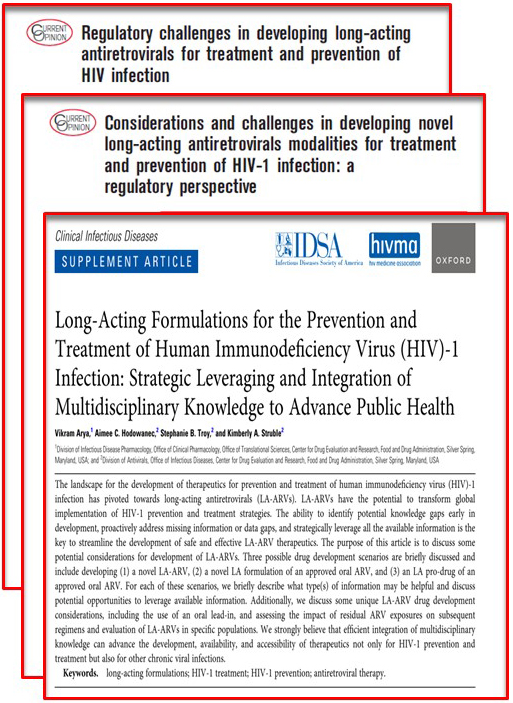Conversion of an oral approved Antiretroviral (ARV) Drug
to a Long-Acting (LA) formulation: a few considerations
Speaker: Vikram Arya, Associate Director for Therapeutic Review (ADTR), Division of Infectious
Disease Pharmacology (DIDP), Center for Drug Evaluation and Research (CDER), US FDA

Background:
Combination antiretroviral therapy has truly revolutionized the treatment of HIV-1 infection and the availability of several safe, convenient, generally well-tolerated, and effective treatment options have reduced mortality and morbidity rates and improved the overall quality of life. Although the currently available prevention and treatment options have markedly reduced the number of new infections and have ensured chronic viral load suppression for majority of patients, factors such as high pill burden, suboptimal adherence, and frequent dosing requirements present formidable barriers to realizing the full potential of prevention and treatment strategies.
Over the past few years, there has been a considerable investment of regulatory time and effort to facilitate the development of LA-ARV formulations resulting in a series of several peer reviewed publications.

- The first publication (PMID # 26049954) described how the development of LA ARVs can present novel regulatory challenges such as determining the appropriate dosing regimen, the need for an oral lead-in (given the slower rate of drug release), and whether existing data with an approved oral formulation, if available, can be leveraged for a treatment or prevention indication.
- A few years later, the second paper in this series (PMID # 31483323) discussed some key considerations for the development of LA injectables, implants, and patches for the treatment and prevention of HIV-1 infection and focused on discussing the utility of an oral formulation option for a LA product, the impact of residual drug(s) concentrations following the discontinuation of the LA formulation, and the use of the LA formulation in specific populations. In addition, related to the availability and use of the oral formulation, the concept of a “hybrid approach” was discussed which can facilitate the transition from an oral formulation to a LA formulation while collecting the required pharmacokinetic, safety, and efficacy data. The central idea of this “hybrid approach” was that an oral formulation can be used early in development to assess single and multiple dose pharmacokinetics, safety, and drug-drug interactions. The results of such trials can generally be extrapolated to the LA formulation if similarity in systemic exposures between the oral and LA formulations can be adequately demonstrated. Subsequently, Phase 2 trials can include LA formulation treatment arms with and without an oral lead-in. If similar safety and efficacy data are observed in both arms, then future Phase 2–3 trials can be conducted with only the LA formulation.
- The latest paper in this series (PMID # 36410378) discussed how LA-ARVs have the potential to transform global implementation of HIV-1 prevention and treatment strategies and specifically discussed three drug development scenarios.
Scenario 1: Development of a novel LA-ARV (new molecular entity)
- General development paradigm is similar to the development pathway for immediate-release oral products:
- In-vitro antiviral activity, non-clinical data and PK/safety data from Single Ascending Dose (SAD)/Multiple Ascending Dose (MAD) studies inform selection of dosing regimens to be evaluated in Proof-of-Concept (POC) trials, followed by Phase 2 and Phase 3 trials.
- Absorption, Distribution, Metabolism, and Excretion (ADME) characteristics inform the need to evaluate the effect of intrinsic (for example hepatic and renal impairment) and extrinsic factors (for example drug-drug interactions) on the pharmacokinetics of the drug.
- Model-informed drug development approaches are often used for optimizing dosing regimens, therapeutic individualization, and overall risk-benefit assessment.
- Considerations specific to LA-ARVs:
- Should an oral immediate-release formulation of the LA-ARV also be developed for administration in a lead-in phase prior to administration of the LA product?
- What are the implications of the residual drug concentrations once dosing of a long-acting formulation is discontinued and the potential impact of these residual concentrations on future treatment or prevention options?
Scenario 2: Development of a LA formulation of an approved oral ARV product
Two overarching questions to consider under this scenario are:
- What information may be leveraged?
- How much information may be leveraged?
- Initial dosing selection and dosing regimen optimization – available PK/PD/ADME data from the oral product can be leveraged using quantitative methodologies to select the dosing regimen (s) of the LA product for characterizing its PK and safety.
- Comparison of systemic exposures of the ARV after administration of the LA product and the oral product- exposure-response information from the oral product can help to contextualize this comparison, especially related to assessing whether efficacy can be extrapolated across the two products.
- The LA product may have unique safety-related considerations (e.g., ISRs) that need to be carefully considered.
- Existing information on the effect of intrinsic and extrinsic factors on the PK of the oral product can facilitate therapeutic individualization of the LA product.
- Available data with the oral product can be very informative to determine management strategies for treatment interruptions and the impact of residual drug concentrations on subsequent therapeutic interventions.
Scenario 3: Development of a LA pro-drug of an approved oral ARV
- If the LA pro-drug is being developed for a similar indication and assuming the pro-drug in itself does not exhibit any unique safety issues, development considerations for this scenario are similar to scenario 2.
- Ability to leverage information depends on the available exposure-response information with the oral product, whether similarity in exposures between the immediate release product and the LA pro-drug of the immediate release oral product has been demonstrated and judicious selection and application of quantitative methodologies to address the clinically pertinent questions.
Summary:
- LA-ARVs have the potential to transform global implementation of HIV-1 treatment and prevention strategies.
- Depending on the development scenario, development of LA ARVs can be streamlined by identifying potential knowledge gaps early in development, actively generating missing information, and strategically leveraging available data.
- Efficient integration of multi-disciplinary knowledge, collaborative engagement of all stakeholders, and judicious use of quantitative tools has the potential to transform the availability and accessibility of therapeutics for not only HIV-1 infection and treatment but also for other chronic viral infections.
